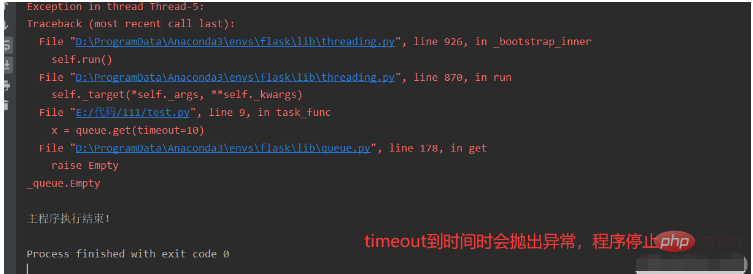python中使用到的队列模块大致有三个:
1、from queue import Queue
此模块适用于线程间通信,但不能用于进程间通信。
示例代码1: 【注意:此时代码存在错误!!!】
import time
import threading
from queue import Queue
def task_func():
global queue
while queue.qsize() > 0:
x = queue.get()
print(f"num: {x}")
time.sleep(0.1)
def producer_data():
global queue
for i in range(100):
queue.put(i)
time.sleep(0.1)
if __name__ == '__main__':
queue = Queue()
producer_thread = threading.Thread(target=producer_data)
producer_thread.start()
thread_list = []
for i in range(5):
thread = threading.Thread(target=task_func)
thread.start()
thread_list.append(thread)
for thread in thread_list:
thread.join()
print("主程序执行结束!")注意:上述写法:
while queue.qsize() > 0:
x = queue.get()当生产者速度没有消费者速度快时,上述消费者代码会提前结束,导致生产者的速度不能消费。
while True:
x = queue.get()这种写法也存在问题,此时消费者队列会一直监听生产者队列是否有数据,导致线程一直处于阻塞状态,程序会一直阻塞不会停止,严重浪费系统资源。如果使用apscheduler等定时任务的库的话,会导致定时任务无法启动。
其实queue队列中的put()或者get()方法中都提供了timeout参数,利用这个参数可以有效解决上述消除不能消费和线程一直阻塞问题。
示例代码2:
import time
import threading
from queue import Queue
def task_func():
global queue
while True:
x = queue.get(timeout=10)
print(f"num: {x}")
def producer_data():
global queue
for i in range(100):
queue.put(i)
time.sleep(0.1)
if __name__ == '__main__':
queue = Queue()
producer_thread = threading.Thread(target=producer_data)
producer_thread.start()
thread_list = []
for i in range(5):
thread = threading.Thread(target=task_func)
thread.start()
thread_list.append(thread)
for thread in thread_list:
thread.join()
print("主程序执行结束!")运行结果:

根据不同的情境,可以根据实际情况设置timeout的值。如果使用定时任务,使用timeout是可以的,不会使程序抛异常停止的。
2、from multiprocessing import Queue
此模块用于对进程,但是不能用于进程池
示例代码:
import time
from multiprocessing import Process, Queue
import queue
def producer(queue):
queue.put("a")
time.sleep(2)
def consumer(queue):
time.sleep(2)
data = queue.get()
print(data)
if __name__ == "__main__":
# queue = queue.Queue()
queue = Queue()
my_producer = Process(target=producer, args=(queue, ))
my_consumer = Process(target=consumer, args=(queue, ))
my_producer.start()
my_consumer.start()
my_producer.join()
my_consumer.join()
# 使用queue模块的Queue()会报错
# 使用multiprocessing中的Queue(),正确输出a运行结果:

3、from multiprocessing import Manager
示例代码:
import time
from multiprocessing import Process, Queue, Pool, Manager
def producer(queue):
queue.put("a")
time.sleep(2)
def consumer(queue):
time.sleep(2)
data = queue.get()
print(data)
if __name__ == "__main__":
# queue = Queue()
queue = Manager().Queue()
pool = Pool()
# pool中的进程间通信需要使用Manager
pool.apply_async(producer, args=(queue, ))
pool.apply_async(consumer, args=(queue, ))
pool.close()
pool.join()运行结果:

以上是Python队列的使用方法有哪些的详细内容。更多信息请关注PHP中文网其他相关文章!
 Python vs. C:了解关键差异Apr 21, 2025 am 12:18 AM
Python vs. C:了解关键差异Apr 21, 2025 am 12:18 AMPython和C 各有优势,选择应基于项目需求。1)Python适合快速开发和数据处理,因其简洁语法和动态类型。2)C 适用于高性能和系统编程,因其静态类型和手动内存管理。
 Python vs.C:您的项目选择哪种语言?Apr 21, 2025 am 12:17 AM
Python vs.C:您的项目选择哪种语言?Apr 21, 2025 am 12:17 AM选择Python还是C 取决于项目需求:1)如果需要快速开发、数据处理和原型设计,选择Python;2)如果需要高性能、低延迟和接近硬件的控制,选择C 。
 达到python目标:每天2小时的力量Apr 20, 2025 am 12:21 AM
达到python目标:每天2小时的力量Apr 20, 2025 am 12:21 AM通过每天投入2小时的Python学习,可以有效提升编程技能。1.学习新知识:阅读文档或观看教程。2.实践:编写代码和完成练习。3.复习:巩固所学内容。4.项目实践:应用所学于实际项目中。这样的结构化学习计划能帮助你系统掌握Python并实现职业目标。
 最大化2小时:有效的Python学习策略Apr 20, 2025 am 12:20 AM
最大化2小时:有效的Python学习策略Apr 20, 2025 am 12:20 AM在两小时内高效学习Python的方法包括:1.回顾基础知识,确保熟悉Python的安装和基本语法;2.理解Python的核心概念,如变量、列表、函数等;3.通过使用示例掌握基本和高级用法;4.学习常见错误与调试技巧;5.应用性能优化与最佳实践,如使用列表推导式和遵循PEP8风格指南。
 在Python和C之间进行选择:适合您的语言Apr 20, 2025 am 12:20 AM
在Python和C之间进行选择:适合您的语言Apr 20, 2025 am 12:20 AMPython适合初学者和数据科学,C 适用于系统编程和游戏开发。1.Python简洁易用,适用于数据科学和Web开发。2.C 提供高性能和控制力,适用于游戏开发和系统编程。选择应基于项目需求和个人兴趣。
 Python与C:编程语言的比较分析Apr 20, 2025 am 12:14 AM
Python与C:编程语言的比较分析Apr 20, 2025 am 12:14 AMPython更适合数据科学和快速开发,C 更适合高性能和系统编程。1.Python语法简洁,易于学习,适用于数据处理和科学计算。2.C 语法复杂,但性能优越,常用于游戏开发和系统编程。
 每天2小时:Python学习的潜力Apr 20, 2025 am 12:14 AM
每天2小时:Python学习的潜力Apr 20, 2025 am 12:14 AM每天投入两小时学习Python是可行的。1.学习新知识:用一小时学习新概念,如列表和字典。2.实践和练习:用一小时进行编程练习,如编写小程序。通过合理规划和坚持不懈,你可以在短时间内掌握Python的核心概念。
 Python与C:学习曲线和易用性Apr 19, 2025 am 12:20 AM
Python与C:学习曲线和易用性Apr 19, 2025 am 12:20 AMPython更易学且易用,C 则更强大但复杂。1.Python语法简洁,适合初学者,动态类型和自动内存管理使其易用,但可能导致运行时错误。2.C 提供低级控制和高级特性,适合高性能应用,但学习门槛高,需手动管理内存和类型安全。


热AI工具

Undresser.AI Undress
人工智能驱动的应用程序,用于创建逼真的裸体照片

AI Clothes Remover
用于从照片中去除衣服的在线人工智能工具。

Undress AI Tool
免费脱衣服图片

Clothoff.io
AI脱衣机

Video Face Swap
使用我们完全免费的人工智能换脸工具轻松在任何视频中换脸!

热门文章

热工具

EditPlus 中文破解版
体积小,语法高亮,不支持代码提示功能

ZendStudio 13.5.1 Mac
功能强大的PHP集成开发环境

DVWA
Damn Vulnerable Web App (DVWA) 是一个PHP/MySQL的Web应用程序,非常容易受到攻击。它的主要目标是成为安全专业人员在合法环境中测试自己的技能和工具的辅助工具,帮助Web开发人员更好地理解保护Web应用程序的过程,并帮助教师/学生在课堂环境中教授/学习Web应用程序安全。DVWA的目标是通过简单直接的界面练习一些最常见的Web漏洞,难度各不相同。请注意,该软件中

螳螂BT
Mantis是一个易于部署的基于Web的缺陷跟踪工具,用于帮助产品缺陷跟踪。它需要PHP、MySQL和一个Web服务器。请查看我们的演示和托管服务。

mPDF
mPDF是一个PHP库,可以从UTF-8编码的HTML生成PDF文件。原作者Ian Back编写mPDF以从他的网站上“即时”输出PDF文件,并处理不同的语言。与原始脚本如HTML2FPDF相比,它的速度较慢,并且在使用Unicode字体时生成的文件较大,但支持CSS样式等,并进行了大量增强。支持几乎所有语言,包括RTL(阿拉伯语和希伯来语)和CJK(中日韩)。支持嵌套的块级元素(如P、DIV),






